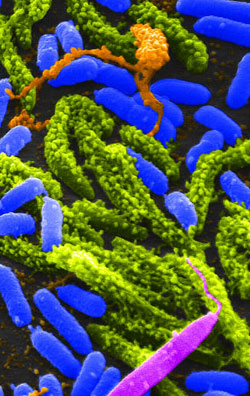
Cholera is a dramatic and terrifying illness characterized by painless watery diarrhoea and copious effortless vomiting leading to shock and death in less than 24 hours. Natural infection occurs only in humans. This acute diarrheal disease is caused by Vibrio cholera.
The bacterium is a ‘comma’ shaped bacilli showing characteristic vibrating motility. They show a ‘swarm of gnats’ appearance under the microscope. They are aerobic in nature and grow well at an optimum temperature of 370C. About 6% of sodium chloride inhibits their growth. They are susceptible to drying, heat and acids. On dried linen or thread, they can survive up to 1-3 days.
In humans, the Vibrio enters the body orally through contaminated food or water. In the small intestine the bacilli crosses the mucus layer and reaches the epithelial cells. Slowly they spread to the other parts of the intestine and also causes shedding of bacteria through feces. The easy attachment to the walls of the intestine is helped by special structures called as ‘toxin co-regulated pilus’. They do not cause any damage to the attached cells. The changes they bring about are biochemical and not histological.
The incubation period varies from less than 24 hours to about 5 days. Clinical illness begins slowly with mild diarrhea and vomiting in 1-3 days, or suddenly with massive diarrhea. Features also include colorless, watery fluid like stool with flecks of mucus, resembling the water in which the rice has been washed, called as ‘rice water stools’. It has a non-offensive sweetish odor. It contains lots of bicarbonate, electrolytes and a little protein.
Common complications are muscular shock, renal failure, pulmonary edema, etc. The clinical severity varies from a fatal condition to momentary colonization of Vibrios in the intestine. There they produce a toxin; cholera toxin. This toxin molecule has got A and B subunits. Two fragments A1 and A2 are formed during transportation.
A1 fragment causes lengthened activation of cellular adenylate cyclate and accumulation of cAMP, thereby causing an outpour of large quantities of water and electrolytes into the small intestinal lumen, and thus resulting in watery diarrhoea. The sodium and chloride absorption in the intestine are also inhibited by the toxin.
Stool of patients are tested for the presence of Vibrio. Rectal swabs are also taken at times. Serological tests like indirect hemagglutination, vibriocidal test and antitoxin assay are done. Vibrio phage typing is also being done in certain cases. Vibrio colonies are typically identified by the ‘string test’. ‘Cholera red reaction’ is another characteristic test for its identification.
The treatment of cholera essentially consists of the replacement of water and electrolytes lost from the body. Glucose and electrolytes being administered orally either alone or with intravenous fluids is a successful method for treatment. Cereal based preparations also prove to be effective. Oral tetracycline is administered to reduce the number of bacteria from parenteral fluids.
Prevention of cholera essentially requires protected water supply and improvement of environmental sanitation. Since these are not attainable in certain endemic regions, vaccination proves to be helpful. The vaccines contain killed suspensions of the cholera bacilli and are given as intramuscular injections. Since injectable vaccines proved to be less effective against intestinal colonization, oral vaccines have been introduced. Two types of its kind are there; killed oral whole cell vaccines and live oral vaccines. But still an ideal cholera vaccine is to yet to be found out.





